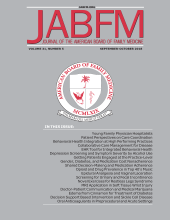Abstract
Background: Increased drug overdose deaths have become a serious public health problem. Primary care providers prescribe about 50% all opioid medications. This study examined opioids prescribing during primary visits to patients with a pain-depression dyad and patient demographic characteristics associated with opioids prescribing.
Method: This study analyzed data from the 2014 to 2015 National Ambulatory Medical Care Survey and included primary care visits by adult patients (aged 18 years or older) with noncancer pain.
Results: An opioid medication was prescribed in 26.4% (95% CI, 22.6% to 30.6%) of the primary care visits by patients with noncancer pain. Opioid medications were more likely to be prescribed during visits by patients with a pain and depression dyad (adjusted odds ratios [AOR] = 1.8; 95% CI, 1.4 to 2.4). Narcotic analgesics were more likely to be prescribed during visits by patients aged 46 to 64 years; by male patients or non-Hispanic white patients.
Discussion/Conclusions: Pain-depression dyad is associated with higher odds of opioids prescribing during primary care visits. Future studies are needed to understand the complexity of these factors and identify effective strategies to prevent opioids addiction and overdose among patients with pain and depression.







